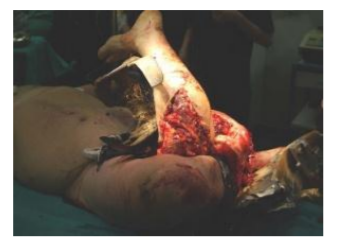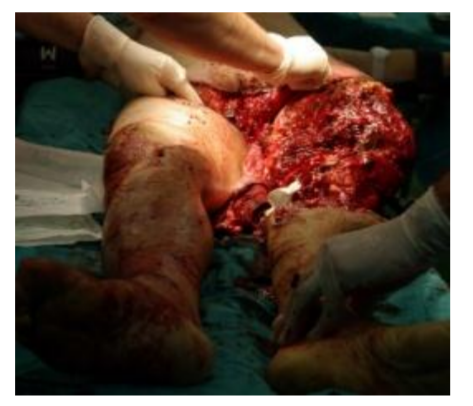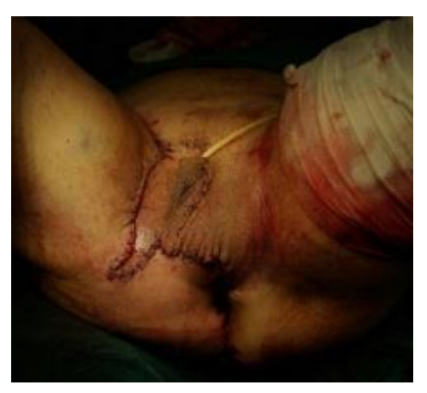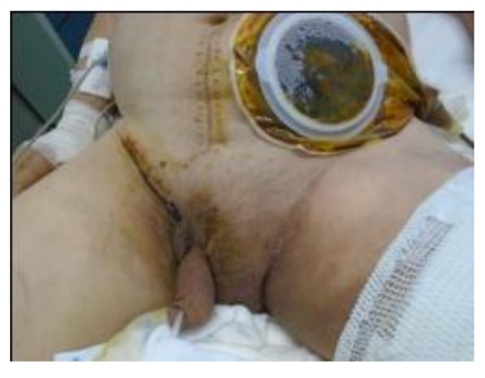Information
Journal Policies
Perineal and Lower Extremity Severe Injuries in Accident with Agricultural Machinery-A Case Report
Konstantinos A Paschos1*, Konstantinos Boulas1, Ilias Bogiatzis2, Anestis Chatzigeorgiadis1
2.Department of Anesthesiology, General Hospital of Drama, Greece.
Copyright : © 2018 Authors. This is an open-access article distributed under the terms of the Creative Commons Attribution License, which permits unrestricted use, distribution, and reproduction in any medium, provided the original author and source are credited.
Mechanical equipment has been widely used in agriculture nowadays. The operators of mainly light, hand-operated machines may be non-professionals, who have limited knowledge of safety instructions, no relevant skills and no training. Consequently, the incidence of serious or lethal injuries by rotating blades and other dangerous mechanical accessories has increased sharply. Lower extremities are primarily affected, followed by upper extremities, the head and the trunk. This case report describes a 72-year-old male patientwith severe perineal and lower extremity injuries caused by a hand-operated rotary tiller. His legs were trapped among the blades of the machine, which were removed to release his legs in the operating theater. His traumas were treated surgically and he was discharged 30 days later. Following his left above the knee amputation, he managed to return to normal life with an artificial limb. Agricultural modern machinery may cause complex injuries, which need prompt assessment and resuscitation, surgical intervention and close cooperation of multiple specialties. The aim is primarily to stabilize the patient and then to prevent permanent disabilities.
agriculture, injury, leg, lower extremity, machines, perineum, trauma,Clinical Case Reports
1. Introduction
Agricultural machinery constitutes an integral part of farmer’s work globally, nowadays. These machines are manufactured in great numbers by robust and persistent materials and could be obtained with low cost in most developed countries. This wide use has substantially inreased agricultural production and decreased the needs for human labor; however, it has also considerably increased the incidence of serious or lethal accidents during agricultural and forestry work with heavy or light machinery. This worrisome phenomenon is further accentuated, as more and more non prefessional farmers and civialians tend to undertake outdoors and farming duties, using mainly small or hand-operated machines, which may cause serious traumas or even death under careless or improper use[1,2]. Across the European continent, the incidence of fatal accidents in agriculture and forestry is comparable only with construction industry, although the numbers of the latter appear to continuously decline, while they increase for agriculture and forestry[3]. In Greece, a country with 4.15 million hectares of utilized agricultural area,almost 82% of the country’s area, 38.000 agricultural accidents are recorded each year, compared to 16.000 in construction industry; notably most of the incidents are not officially recorded[4].
The accident scenarios in which people are seriously injured include loss of control, slipping, stumbling and/or falling of the operator (especially with hand-operated machines), as well as breakage, bursting, slipping and/or splitting of material agents. Most importantly, safety consiousness is not always taken for granted as statistics showed that the majority of machinery-related accidents occur as a result of the operator’s negligence; errors may include taking shortcuts to save time, ignorance of the operator’s manual and safety instructions (especially non professional operators), improper clothing and/or smoking during the work, failing to follow safety rules, improper machinery maintenance, touching sharp and rotating objects (e.g. blades)[5,6].
Accidents caused by agricultural machinery may be very serious or lethal. They usually demand immediate transportation to a hospital, preferably trauma center, meticulous resursitation and surgical interventions. The close and coordinated collaboation of multiple medical specialties, such as surgeons (general, plastic, vascular, orthopaedic, urology, neuro), radiologists, anesthetists and intensivists is usually mandatory and crucial to succeed the least of fatalities and substantially limit permanent tissue damages and disabilities[7]. This case report presents a serious accident caused by the use of a hand-operated rotary tiller, where perineal and lower extremity traumas occurred. The patient was treated in a secodary general hospital by general surgeons, orthopaedic surgeons, anesthetists and intensivists.
2. Case Presentation
A 72-year old man was admitted at the Emergency Department (ED) polytraumatized by an agricultural hand-operated rotary tiller, ploughing mechanical equipment with groups of rotating blades for turning the soil before planting. While he was pushing the rotating machine on the ground in his private farm, his trousers were trapped in the blades;consequently the rotating blades almost amputated his left thigh, 10cm above the knee and trapped his right leg, while a blade penetrated his perineal soft tissue. The paramedics and the firemen, who rushed at the farm, removed part of the machinery with chainsaws and carried the patient with part of the implement between his legs at the hospital.
On physical examination he was fully conscious, Glasgow Coma Scale (GCS)=15 and afebrile; his blood pressure was 95/70mmHg, his pulse was regular at 120/min and O2 saturation was 97%. He presented a complicated perineal trauma, where a blade had torn the skin of thescrotumup to the anus, cut small blood vessels, destroyedhalf of the external part of the anal verge, as well as half of the scrotum, exposing the testicles and destroyedthe skin of the right inguinal area. Also, he suffered from a catastrophic left femoral and knee trauma, where only the skin of the posteriorthigh was intact, while his right leg was trapped among the blades and part of the machine’s main body.Initial laboratory data showed mild neutrophil leukocytosis (White Blood Cell count (WBC): 11.6k/ul, NEUT: 90.7%), hemoglobin level at 12.5g/dl and normal kidney and liver function profile. His past medical history included mild arterial hypertension.
A subclavian vein central catheter was inserted along with a nasogastric tube and a Foley catheter, as his urethra and his urinary bladder were intact. He immediately received iv fluids (Ringer’s lactated (R/L)) and antibiotics (second geneation cephalosporin), was intubated and was transferred to the operating theater (OT) with the machinery materials, because they could not be removed at the ED (Figure 1). He underwent no radiological imaging due to the gavity of his clinical situation, the potential hemodynamic instability and the large metal materials that were attached to his body.
Under general anesthesia his right leg was released from the machine using powerful plumber tools to bend the blades, while his left lower extremity was meticulously irrigated with povidone iodine, hydrogenperoxide and eventually 2 lt of R/L and then was amputated at the centraltertile of the thigh (Figure 2). The perineal and inguinal trauma was analogously washed, necrotic tissue was removed, blood vessels were ligated and the skin was repaired with interrupted sutures, as the external anal sphincter was intact (Figure 3). Additionally, adiverting loop sigmoidostomy was performed via an infraumbilical midline incision, to allow healing of the perineal trauma, avoiding fecal contamination.
The patient remained at the intensive care unit (ICU) for 5 days and subsequently was transferred at the surgical department. His injuries were cleaned daily, while the femoral stump was subjected to some additional surgical debridement postoperatively (Figure 4). In general he had an uneventful recovery and was discharged the 25th postoperative day. Three months later his bowel integrity was restored and he started walking with an artificial limb.
3. Discussion
The increased use of machines in every day agricultural tasks, along with the considerable use of such machinery by non-professionals, has multiplied the incidence and the severity of agriculture-related accidents. Interestingly, people living in cities tend to buy farms and cottages to spend time in the countryside and cultivate their own products. Subsequently, they have to perform agricultural tasks and they seek the aid of available and easily-acquired machinery, which they use usually without the proper knowledge, training or skills[8].
Hand-operated machines (rotary tractors, plow tractors or tillers) are most frequently bought by such “amateur farmers”. Their average weight is 100-150 kg, their horse power (HP) is about 10 HP and they have multiple groups of rotating dry land blades from stainless steel, each bladeweighing about 0.5kgr. This ploughing equipment may achieve a tilling depth of 10-20cm. These figures show the importance of proper use and the necessity of adherence to safety rules. Ignorance and negligence may cause fatal incidents. As untrained people usually work in private farms for recreational and self-content reasons, in their majority of middle or old age, accidents are not rare and the numbers of serious injuries have increased sharply in developed and developing countries[9].
The majority of people injured by agricultural machinery are men, older than 40 years.
Accidents usually occur in spring and summer, rather than autumn and winter; also in weekdays than in the weekends. The main parameters that predispose and influence the risk of accidents and the severity of injuries are the operator’s clothes, human behavior (improper care, smoking, alcohol consumption), knowledge of safety rules and experience, nature of the ground (stiff slopes, dry land), machinery maintenance. Loss of control is followed by the operator’s fall as common deviation leading to an injury. Hand-operated machines are the most dangerous compared with self-propelled machines and means of transports. Lower extremities are mainly affected by such equipment, including superficial injuries to fractures, amputations and burns, while upper extremities, the torso and the head follow. As rotating blades are usually involved, when the accident occurs, serious tissue damage or even death is the consequent effect[5,2].
These patients may be in critical condition, covered in dirt, soil or plants, or rarely may be trapped in the equipment as with our patient. The active participation of multiple surgical specialties is mandatory, with general surgeons having the main role. Immediate resuscitation, airway control, wide-bore vascular access and fluid infusion are the initial steps, along with antibiotic infusion. The patient should be transferred to the OT as soon as possible, when they are unstable due to major trauma. Uncontrolled bleeding is the main concern, and packing may be used when pelvic or retroperitoneal bleeding appears. Fixation of bones should follow, especially when the pelvis is damaged[10,11]. Necrotic tissue should be removed and meticulous washing should be performed to clean foreign bodies and dirt. In case of catastrophic traumas in the abdomen or the perineum, damage control surgery may include pelvic packing, diverting stoma and later return to the theater. When the patient is stable transportation to a specialized trauma unit may also be considered. Complicated rectal and urinary tract injuries may need treatment in tertiary medical centers[12,13].
Our patient was admitted in a stable condition at the ED, although trapped in the equipment. The challenge for the medical personnel was initially to remove the metal materials, free his lower extremities and subsequently to treat the extensive perineal trauma. All tissue damage was mainly repaired by general surgeons at the OT, shortly after the patient‘s admission at the hospital. The following postoperative days he underwent only limited tissue debridement. His recovery was uncomplicated and 3 months later he returned to normal life with an artificial limb. The other limb, although excessively bended during the accident and trapped for 1.5 hour in the machinery, it only suffered mild muscular strain and tendinitis that were treated conservatively.
4. Conclusions
As hand operated agricultural machines become widely available and more people, mostly city residents, tend to undertake agricultural tasks to cultivate their own natural products, accidents become more frequent. These machines include rotating blades and may cause serious or lethal injuries. Complex perineal and lower extremity traumas may occur and then prompt initial medical assessment, immediate resuscitation, and surgical intervention are crucial. Multiple medical specialists must work together, attempting primarily to stabilize the patient and subsequently to impede permanent disorders and disabilities. A wide range of techniques and maneuvers may be included and the medical personnel should be trained to cooperate and act promptly and effectively.
References
- Rautiainen R.H., Lehtola M.M., Day L.M., Schonstein E., Suutarinen J., Salminen S. and Verbeek J., Interventions for preventing injuries in the agricultural industry, Cochrane Database Syst.Rev. (1), CD006398 (2008).
- Haan J.M., Hauschild D., Patterson C., Ward J.G. and Helmer S.D., Fatal Agricultural Accidents in Kansas: A Thirty-One-Year Study, Am. Surg. 84 (4), 581-586(2018).
- Eurostat, General mortality, Causes of death, (2015) https://ec.europa.eu/eurostat/web/health/causes-death/data/database, [accessed: 18-12-2018].
- European Commission, Agriculture in the EU, Statistical and Economic Information, Report 2013. Brussels.
- Kogler R., Quendler E. and Boxberger J., Occupational accidents with mowing machines in Austrian agriculture, Ann. Agric. Environ. Med. 22 (1), 137-141(2015).
- Bunn T.L., Slavova S. and Hall L., Narrative text analysis of Kentucky tractor fatality reports. Acc. Anal. Prev. 40 (2), 419-425(2008).
- Mayrhofer H., Quendler E. and Boxberger J., Narrative text analysis of accident reports with tractors, self-propelled harvesting machinery and materials handling machinery in Austrian agriculture from 2008 to 2010 - a comparison, Ann. Agric. Environ. Med. 21 (1), 183-188(2014).
- Caffaro F., Roccato M., Micheletti Cremasco M. and Cavallo E., Part-time farmers and accidents with agricultural machinery: a moderated mediated model on the role played by frequency of use and unsafe beliefs, J.Occup.Health. 60 (1), 80-84(2018).
- Margentino M., Farm Machinery and Equipment Safety Part II: Preventing Machinery Accidents During Operation, The State University of New Jersey, New Jersey (2007).
- Rizzi L. and Castelli C., Open pelvic fracture associated with lumbosacral dislocation and extensive perineal injury, Injury. 46 (Suppl 7), S44-47(2015).
- MacFarlane C., Vaizey C.J. and Benn C.A., Battle injuries of the rectum: options for the field surgeon, J. R. Army. Med. Corps. 148 (1), 27-31(2002).
- de Oliveira P.S., de Oliveira T.R., Martinho D. andMartins F., "Horrendoplasty" - A case of total perineal destruction by agricultural implement, Urol.Ann. 9 (4), 403-406 (2017).
- Zuccon W., Paternollo R., Del Re L., Cordovana A., De Murtas G., Gaverini G., Baffa G.and Lunghi C., Emergency treatment of violent trauma: clinical cases and surgical treatment of penetrating thoracoabdominal, perineal and anorectal trauma, Ann.Ital.Chir. 84(1), 11-18(2013).








